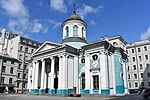Municipal Okrug 78
Tsentralny District, Saint PetersburgUse mdy dates from April 2013

Municipal Okrug 78 (Russian: муниципа́льный о́круг № 78) is a municipal okrug of Tsentralny District of the federal city of St. Petersburg, Russia. Population: 11,186 (2010 Census); 13,508 (2002 Census).The okrug borders Nevsky Avenue in the northeast, the Fontanka River in the south, and Gorokhovaya Street in the west. Places of interest include the Kazan Cathedral, the Merchant Court, the Apraksin Dvor, the Alexandrinsky Theatre, and the Saint Petersburg City Duma.
Excerpt from the Wikipedia article Municipal Okrug 78 (License: CC BY-SA 3.0, Authors, Images).Municipal Okrug 78
Sadovaya street, Saint Petersburg Apraksin Dvor (округ № 78)
Geographical coordinates (GPS) Address Nearby Places Show on map
Geographical coordinates (GPS)
| Latitude | Longitude |
|---|---|
| N 59.9333 ° | E 30.3333 ° |
Address
Sadovaya street 22
191023 Saint Petersburg, Apraksin Dvor (округ № 78)
Saint Petersburg, Russia
Open on Google Maps









